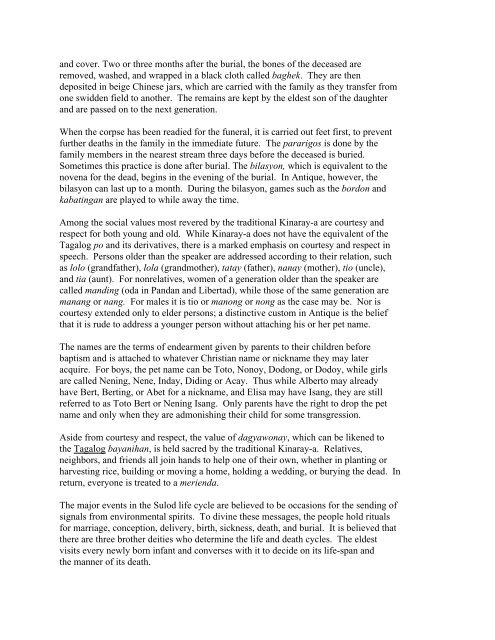Kinaray-a
Kinaray-a
Kinaray-a
Create successful ePaper yourself
Turn your PDF publications into a flip-book with our unique Google optimized e-Paper software.
and cover. Two or three months after the burial, the bones of the deceased are<br />
removed, washed, and wrapped in a black cloth called baghek. They are then<br />
deposited in beige Chinese jars, which are carried with the family as they transfer from<br />
one swidden field to another. The remains are kept by the eldest son of the daughter<br />
and are passed on to the next generation.<br />
When the corpse has been readied for the funeral, it is carried out feet first, to prevent<br />
further deaths in the family in the immediate future. The pararigos is done by the<br />
family members in the nearest stream three days before the deceased is buried.<br />
Sometimes this practice is done after burial. The bilasyon, which is equivalent to the<br />
novena for the dead, begins in the evening of the burial. In Antique, however, the<br />
bilasyon can last up to a month. During the bilasyon, games such as the bordon and<br />
kabatingan are played to while away the time.<br />
Among the social values most revered by the traditional <strong>Kinaray</strong>-a are courtesy and<br />
respect for both young and old. While <strong>Kinaray</strong>-a does not have the equivalent of the<br />
Tagalog po and its derivatives, there is a marked emphasis on courtesy and respect in<br />
speech. Persons older than the speaker are addressed according to their relation, such<br />
as lolo (grandfather), lola (grandmother), tatay (father), nanay (mother), tio (uncle),<br />
and tia (aunt). For nonrelatives, women of a generation older than the speaker are<br />
called manding (oda in Pandan and Libertad), while those of the same generation are<br />
manang or nang. For males it is tio or manong or nong as the case may be. Nor is<br />
courtesy extended only to elder persons; a distinctive custom in Antique is the belief<br />
that it is rude to address a younger person without attaching his or her pet name.<br />
The names are the terms of endearment given by parents to their children before<br />
baptism and is attached to whatever Christian name or nickname they may later<br />
acquire. For boys, the pet name can be Toto, Nonoy, Dodong, or Dodoy, while girls<br />
are called Nening, Nene, Inday, Diding or Acay. Thus while Alberto may already<br />
have Bert, Berting, or Abet for a nickname, and Elisa may have Isang, they are still<br />
referred to as Toto Bert or Nening Isang. Only parents have the right to drop the pet<br />
name and only when they are admonishing their child for some transgression.<br />
Aside from courtesy and respect, the value of dagyawonay, which can be likened to<br />
the Tagalog bayanihan, is held sacred by the traditional <strong>Kinaray</strong>-a. Relatives,<br />
neighbors, and friends all join hands to help one of their own, whether in planting or<br />
harvesting rice, building or moving a home, holding a wedding, or burying the dead. In<br />
return, everyone is treated to a merienda.<br />
The major events in the Sulod life cycle are believed to be occasions for the sending of<br />
signals from environmental spirits. To divine these messages, the people hold rituals<br />
for marriage, conception, delivery, birth, sickness, death, and burial. It is believed that<br />
there are three brother deities who determine the life and death cycles. The eldest<br />
visits every newly born infant and converses with it to decide on its life-span and<br />
the manner of its death.
















